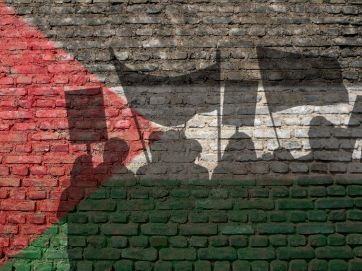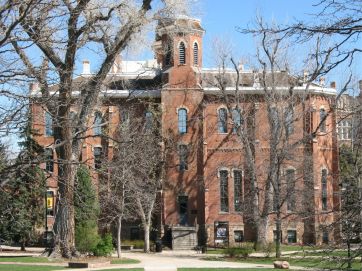The U.S. Department of Education’s Office for Civil Rights has issued a “Dear Colleague” letter with new guidelines that for handling accusations of sexual harassment on college campuses. The guidelines are destined to become strict mandates for colleges to tip the scales of justice in favor of the accuser.
For just about two decades, NAS has been following the implementation and evolution of sexual harassment codes on American college and university campuses. Needless to say, we’ve never had the slightest problem with throwing the book at anyone proven guilty of real harassment, such as the predatory, lecherous professor who extorts sexual favors from students in exchange for higher grades or good recommendations. Nor is genuine harassment limited to quid pro quo sexual transactions. It also includes faculty members or senior administrators who can’t keep their hands to themselves. Sexual harassment so understood is straightforward and incontestable, and that’s how we continue to see it. Such behavior has no place anywhere in the academic enterprise—period—and should be addressed promptly and firmly. If justice should require the dismissal of a tenured professor, so be it.
Alas, it’s never been quite that simple. Many campus codes and policies, as we learned, were deeply problematical and troubling. In January 1993, we set out our concerns in a formal statement, Sexual Harassment and Academic Freedom. We noted there that “sexual harassment” was often defined in a mischievously vague, open-ended manner that extended far beyond conduct, and aggressively intruded into the realm of ideas and classroom discourse. A new and impossibly subjective standard—the “hostile environment”—became the driving force behind an avalanche of complaints, usually having no obvious connection to sexual impropriety. Thus—believe it or not—“callous insensitivity to the experience of women” or arguing that distinct social roles between men and women resulted more from nature than nurture were standard issue in the ever-expanding lexicon of apparent thought offenses that now constituted “harassment.” A local cadre of enforcers in the faculty and administration were commonly the most aggressive movers and shakers: drafting their school’s code, monitoring faculty members and students, “planting” student observers in ideologically suspect courses, encouraging complaints, and staffing the administrative bodies charged with adjudicating them.
It didn’t take much to rev this bureaucratic juggernaut into high gear, either. Inspector Clouseau-style “investigations,” however farcical they might appear to non-academic observers, were often commenced on the basis of ludicrously flimsy pretexts, such as a complainant’s feeling “uncomfortable” during classroom discussions of controversial issues. You might object that charges were frequently subjective and difficult, if not impossible to disprove, but they posed no problem for those eager to organize a posse.
Academic due process, needless to say, often took a big hit. In one particularly egregious case, a senior history professor was handed his pink termination slip, unaware to that point that his academic dean had secretly initiated an “investigation” against him. The dean, who disliked him because of his frequent public dissents from feminist orthodoxy, calculated, with reason, that sexual harassment was the one rap against which there was little defense or recourse. In many cases, all but minimal information was withheld from the accused, lest he “retaliate” against the accuser. Even faculty who were eventually exonerated often found themselves on permanent probation and subject to continued surveillance by campus activists, in whose eyes the failure to prove guilt did not establish innocence.
All of this characterized the wave of hysterical and ideologically driven charges of sexual harassment which sprang up across the United States during the first half of the 1990s. It was primarily the work of what Daphne Patai usefully dubbed the Sexual Harassment Industry (SHI) in a 1998 book, Heterophobia: Sexual Harassment and the Future of Feminism. And while the hysteria eventually abated, the damage had been done. Things quieted on campus, but not because ringing defenses of academic freedom and due process had been thundered from the mountaintop. The largely home-grown coercive machinery of the SHI remained in place, its power to intimidate resoundingly established. Cowed faculty, especially those without tenure, had learned their place and stayed there.
Administrators, when they were not actually the SHI’s eager accomplices, were wont to declare their ceaseless vigilance and resolve to provide harassment-free campuses with “safe” learning environments. On the risk-control advice of legal counsel, many institutions seeking to forestall litigation stampeded to impose still more stringent codes, along with mandatory sexual harassment training sessions for all faculty, staff, and student residence halls. And as occasional new cases would demonstrate, SHI’s daunting power could be revived just about any time, lest anyone forget.
Now fast forward to 4 April 2011 when, without prior notice or external input, the U.S. Education Department’s Office for Civil Rights (OCR) published mandatory new “guidelines” for the adjudication of sexual harassment complaints at all colleges and universities receiving federal funding (which is to say, just about every college and university in the country). OCR has virtually no public visibility, but it wields enormous clout as the agency charged with enforcing federal civil rights statutes applicable to educational institutions or programs receiving federal funds from the DOE, including the Pell grants which figure hugely in the budgets of many schools. Under Title IX of the Education Amendments of 1972, OCR is charged with ensuring that recipient institutions do not discriminate on the basis of sex, and the agency’s considerable power derives from its authority to withhold federal funding from any institution determined to be out of compliance with federal requirements. It also exercises considerable latitude in interpreting federal statutes when determining what constitutes “discrimination” in specific cases.
Obviously, whoever can withhold large sums of money exercises enormous powers of persuasion over those hoping to get them. So when OCR announces just about anything—such as its new guidelines for adjudicating sexual harassment complaints—you’d better believe that recipient institutions will take notice and fall in line. As of this writing, a number of schools, including Yale and Notre Dame, have already hastened to jump through the hoop and have revised their harassment complaint procedures accordingly.
The new regulations, incidentally, came as a bolt from the blue, in striking contrast to past practice. Previously, OCR provided advance notification of proposed new policies and requested commentary from interested parties. Readers may recall a previous go-around with the agency in 1995 when, at our urging, a number of NAS members wrote to take issue with its proposed adoption of the “hostile environment” standard as sufficient grounds for bringing a complaint of sexual harassment. But here at least OCR had requested comments and actually replied in detail to our objections. No such thing this time, just a fait accompli announcing that recipient institutions had their marching orders and were expected to get with the program. And what an astonishing program it is. If you’ve been concerned about the troubled relationships between sexual harassment codes and academic freedom or First Amendment rights and academic due process, you’re not going to feel good about what’s coming to your campus in the near future.
First off, OCR’s 4 April letter makes no mention whatsoever of legitimate and longstanding concerns about academic freedom or of the need to protect First Amendment rights at public institutions, no acknowledgement of the many past difficulties generated by vague and elastic definitions of sexual harassment. In other words, if you think it’s quite a stretch to construe “callous insensitivity to the experience of women” as sexual harassment, you’d better continue to watch what you say and where you say it. Especially ominous is the letter’s failure to reaffirm OCR’s own previous guidance statements stressing the need to apply sexual harassment regulations that also respect the First Amendment rights of students and faculty members. There is no reference, for example, to the July 2003 “Dear Colleague” letter from then-assistant-secretary Gerald A. Reynolds, who addressed free speech issues clearly and directly:
Some colleges and universities have interpreted OCR’s prohibition of “harassment” as encompassing all offensive speech regarding sex, race or other classifications. Harassment, however, to be prohibited by the statutes within OCR’s jurisdiction, must include something beyond the mere expression of views, words, symbols or thoughts that some person finds offensive. Under OCR’s standard, the conduct must also be considered sufficiently serious to deny or limit a student’s ability to participate in or benefit from the educational program . . . . No OCR regulation should be interpreted to impinge upon rights protected under the First Amendment to the U.S. Constitution, or require recipients to enact or enforce codes that punish the exercise of such rights.
OCR’s most recent letter, by contrast, makes no mention of free speech at all, much less stipulate that harassment codes must comport with First Amendment rights. Bite your tongue.
And if you're looking for a more precise definition of what constitutes “sexual harassment,” you won’t find that either. “Sexual harassment,” OCR states,
[is] unwelcome conduct of a sexual nature. It includes unwelcome sexual advances, requests for sexual favors, and other verbal, nonverbal or physical conduct of a sexual nature. Sexual violence is a form of sexual harassment prohibited by Title IX.
Conspicuously missing from this definition is the stipulation that offensive conduct must be “sufficiently severe, persistent or pervasive to limit a student’s ability to participate in an education program.” If you’re wondering what kind of “verbal conduct” might now be construed as harassment, you’ll apparently have to wait until someone accuses you. The letter leaves it at that.
But the single most worrisome aspect of the new regulations is the significantly lighter burden of proof OCR mandates for all campus tribunals investigating and adjudicating sexual harassment complaints. For the best information on the many troubling aspects of OCR’s new regime, visit FIRE at www.thefire.org. Its letter of 5 May to OCR presents an especially detailed and compelling critique.
When the regulations become effective, all such bodies must regard a “preponderance of evidence”—figure 50.01%—as sufficient to establish guilt. That is to say, if the relevant judicial body thinks it’s probable that the accused is guilty, then that’s all they need: guilty!
But wait, you say, isn’t “preponderance of the evidence” used primarily in civil cases, usually concerned with monetary disputes between private individuals? Isn’t sexual harassment something far more serious, for which a guilty verdict carries an indelible stigma and can have major consequences, and so should meet a more strenuous burden of proof, as most campus codes now require?
Not anymore, says OCR. From now on, all schools falling under its jurisdiction must apply the “preponderance of evidence” standard, or they will be determined as “not in compliance,” with the possible loss of federal funding. Who could be surprised, then, that a scramble will probably ensue, to toe OCR’s line? It’s hard to imagine that many schools are going to resist. How many academic legal counselors are going to advise their clients to buck OCR’s edict? Better to play it safe, even if they might have doubts about the new procedures.
But to repeat: Whether they like it or not, recipient institutions must now make it a lot easier to find someone guilty of sexual harassment. That seems to mean that it really isn’t necessary to “prove” that a defendant is guilty, certainly not by the more exacting standards heretofore used. Just suspecting that he is may indeed be good enough. And in the event that a defendant is acquitted, OCR introduces another striking novelty: accusers and accused must have an equal right of appeal. Yes, that’s right. Even with no new evidence or witnesses, the complainant must routinely have the right to appeal an acquittal, with potential re-prosecution of the accused! It doesn’t take much cynicism to come away with the impression that OCR really wants to stick it to the accused. But if you’re still not convinced, have a look at this darkly intriguing statement:
Public and state-supported schools must provide due process to the alleged perpetrator. However, schools should ensure that steps taken to accord due process rights to the alleged perpetrator do not restrict or unnecessarily delay the Title IX protections for the complainant.
This borders on the surreal. Yes, you should see to it that the accused is accorded appropriate due process rights, but at the same time, let’s not get carried away. The complainant’s protections under Title IX are what really matters, and if you have to weigh between one or the other . . . . well? How else can this bizarre formula be understood?
There’s a lot more to say about this, and we will be consulting with FIRE and other allied organizations as we formulate a strategy for coping with this astounding ukase from OCR. The American Association of University Professors has also requested that the new rules be rescinded. It looks to be a long tough haul at minimum, but nearly everything we value as academics is now seriously threatened, and we intend to fight for it.
At the very least, some serious Congressional inquiry is in order, since the agency has clearly legislated, notwithstanding its assertion that the new rules simply constitute “guidance.” For the short term, we suggest that you consider writing to the House Committee on Education and the Workforce—cc. OCR—to protest this bureaucratic usurpation. At the very least you can make them aware of it, and let them know what you think.
This article appeared in NAS Update, the newsletter of the National Association of Scholars.
Image: Golden Lady Liberty by Emmanuel Huybrechts // CC BY













